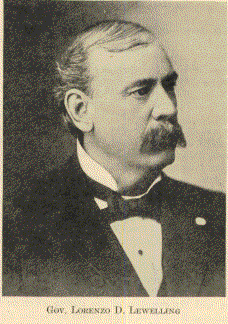| 1918 KANSAS AND KANSANS | Chapter 58 | Part 1 |
CHAPTER LVIII
LORENZO D. LEWELLING

[Copy by Willard of Photograph in Library of Kansas State Historical Society]
Lorenzo D. Lewelling, the twelfth Governor of Kansas, was born December 21, 1846, near Salem, Henry County, Iowa. His father was a Quaker minister. He died in 1848. Seven years later the mother was burned to death. She left a large and helpless family. For a short time Lorenzo made his home with a married sister, but poverty compelled him to leave this refuge and face the world alone. He did any labor that was honest, and his early life was one continuous terrible struggle.
When the Civil War broke out he enlisted in an Iowa regiment. But fighting was against the Quaker creed, and his relatives secured his discharge. After many vicissitudes, he joined a bridge-building corps at Chattanooga, Tennessee. Here he accumulated a small sum of money, with which he entered Eastman's Business College, at Poughkeepsie, New York. After his graduation he worked his way westward, laboring as a tow-boy, a carpenter, a section hand. Once again in Iowa, he earned enough money to enter Whittier College, at Salem. He graduated from this institution when about twenty-one years old, and became a teacher in the Iowa State Reform School.
On April 18, 1870, he married Miss Angie Cook, a teacher in the schools of Red Oak, Iowa. After his marriage he tried farming, which he soon abandoned to found the Register, a Republican weekly, at Salem.
In 1872 Mr. and Mrs. Lewelling were appointed to have charge of the Girls' Department, Iowa State Reform School, which position they held fifteen years, with the exception of two, during which he founded and edited an anti-ring Republican paper known as the Des Moines Capital. Mrs. Lewelling died while Matron of the School, leaving three daughters. Some time later Mr. Lewelling married Miss Ida Bishop, by whom he had one child, a daughter.
In 1887 he brought his family to Wichita, Kansas, and in 1892, was nominated by the Populist party for Governor, and was elected.
Governor Lewelling was inaugurated January 9, 1893, and was Governor of Kansas during the stormiest legislative session in her history.
The Republicans had a majority in the House, but the Populists claimed that it had been secured by fraud. Both parties claimed the right to organize the House. The Republicans elected George L. Douglas speaker, and the Populists J. M. Dunsmore. Prentis says:
|
Both Speakers occupied the same desk, and during the first night slept under the same blanket on the floor in the rear of the Speaker's desk, each one with a gavel in his hand. |
Governor Lewelling recognized the Dunsmore House as legal, on the third day. The Republicans protested, and both Houses continued to sit. An arrangement was effected by which one house met in the morning and the other in the afternoon. Attempts to settle the difficulty were in vain.
The Senate and House met in joint session and elected John Martin United States Senator.
L. C. Gunn, a business man of Parsons, was summoned to testify in a case by the Douglas House. He refused to come, saying the Republican House was illegal, and was arrested by a Republican Sergeant-at-arms. The matter was brought before the Supreme Court. Pending the decision, the officers of the Populist party barricaded themselves in the Hall of Representatives. The next morning, the door was smashed in by members of the Republican House, which entered and took possession.
The situation looking serious, Governor Lewelling called out several companies of State Militia. Guns were brought up and artillerists ordered from Wichita. Sheriff Wilkinson announced himself the only regular guardian of the county peace, and swore in a large force of deputies, acting in the interest of the Republicans.
There was much excitement and Topeka was filled with well-armed men. The Republican House was in a state of siege, food being passed up to the Representatives in baskets lowered from the windows of Representative Hall. On the third day a decision was reached that the Republican House should hold the hall, and the Populists meet elsewhere. This ended the Legislative War of 1893.
On the twenty-fifth of February, the Supreme Court affirmed the constitutionality of the Republican House, and the two Houses united.
So much time was taken up in settling the war that but few laws were passed during this session. However, a constitutional amendment giving women the right of suffrage was submitted to the vote of the people in the election of 1894.
During the administration of Governor Lewelling, the World's Columbian Exposition was held at Chicago, and Kansas was well represented.
In 1894 a general unrest was evident among the poorer people and the laborers. There were many strikes and much discontent and suffering.
In this year it was discovered that Kansas was the possessor of rich oil and gas fields. Many companies were organized, land was leased, and large operations were started. Thus another national resource was added to the wealth of Kansas.
Governor Lewelling was renominated in 1894, but the Republicans carried the election. In 1896 he was elected to the State Senate, and in 1897 was appointed by the Executive Council one of the Board of Railroad Commissioners. He was Chairman of this organization until it was abolished by the Legislature of 1898.
Governor Lewelling died at Arkansas City September 3, 1900. Of all the Governors of Kansas, he probably had most sympathy for the poor.
| 1918 Kansas and Kansans | Previous Section | Next Section |
A Standard History of Kansas and Kansans , written and compiled by William E. Connelley, transcribed by Carolyn Ward, 1998.
